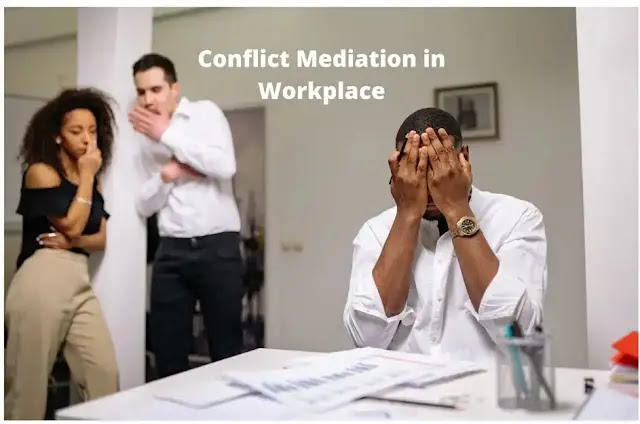The Right Ways to Resolve Conflict in the Workplace
Knowing the right ways and skills for conflict mediation in the workplace is essential for both employers and employees because some conflicts will occur in any workplace.
 |
Conflict mediation in the workplace. |
What is conflict in the workplace?
Conflict in the workplace is a circumstance that occurs between:
- People Who do intertwined jobs.
- People who think that the other is wrong.
- People who feel angry or have negative emotions.
- People whose behavior leads to a problem at work or an organizational problem.
All the above-mentioned conditions must be met to be considered a legitimate workplace dispute that can be resolved using self- or third-party mediation.
Conflict in the workplace does not mean disagreement, hesitation, tension, or mistrust. or dissatisfaction, although this may be a consequence of disputes that occur in the workplace.
Why do conflicts occur in the workplace?
Some common causes lead to conflict in the workplace and they can be summarized in the following points:
- Different expectations regarding needs, desires, interests, values, beliefs, ideologies, customs, standards, status, or power in interpersonal relationships
- Miscommunication.
- Different interpretations of information, behavior, or events.
- Exceeding personal boundaries.
- Limited resources.
- Self-absorption.
- Unresolved conflicts of the past.
Dangerous assumptions that often cause conflict
We assume that:
- Others understand us.
- we can understand others if we fully listen to them.
- Others will have the same reactions to the things you do.
- Others associate the same meanings and words as same as we do.
Conflict Resolution Approaches
Here are the conflict resolution approaches that you can follow to solve the conflict in the workplace.
- Power-Based Approach
- Right-Based Approach
- Interest-based approach
Power-Based Approach:
- This approach uses power, force, and coercion to resolve conflict.
- It is not an ideal solution to enhance cooperation and is only appropriate in some cases such as in the case of a colleague having legal responsibility for a decision that must be made and acted upon quickly.
Right-Based Approach:
- Uses law, custom, or tradition to resolve conflict.
- It determines who is right and who is wrong so that the guilty can be blamed and punished.
- It is not an ideal solution to enhance cooperation and is only appropriate in some cases such as when one colleague needs protection from another colleague.
Interest-based approach:
- The interests-based approach uses people's interests as a basis for negotiation to reach mutually satisfactory solutions between people who need to cooperate.
- When conflicts are resolved based on interests, people are more likely to cooperate rather than compete
- It aims to search for win-win scenarios to make cooperation possible again
- It is the ideal approach to foster collaboration between colleagues.
Common mistakes people make in workplace conflicts
The common mistakes people make when dealing with conflict in the workplace:
- Flee or attack response to escape a problem (avoiding, withdrawing, or leaving) or attacking others (insults, accusations, violence). These flight or fight responses are described as instinctive but have a devastating effect on cooperation.
- Power-based or rights-based approach. Respond using these approaches before attempting an interest-based solution. In both cases, there is a winner and a loser and sometimes both lose out. These solutions usually resolve the conflict in such a way that cooperation is no longer possible.
- Narrow and inaccurate forecast
- Our needs are fundamentally incompatible, only one of us can win.
- Our dispute is a direct result of incompetence, ignorance, defect, or another defect. This dispute can only be resolved if you fix your defects. Our differences are irreconcilable, and agreement is impossible.
How can Mediation Resolve Conflict?
Cultures and different types of personalities handle conflict differently. Almost everyone finds it difficult and embarrassing to resolve conflicts.
However, mediation can work with almost all personality types and different cultures around the world if the following conditions are met:
- Participants have an ongoing and interdependent relationship.
- Both persons are present and involved in the dialogue.
- Everyone can refrain from physical violence.
- The power imbalance is not apparent with much force between the two people.
- Neither of them suffers from severe emotional distress.
- Both people speak a common language.
Using Restorative Signs to End Conflicts in the Workplace
When a person makes a conciliatory gesture (apologizing, giving a gift, or making a positive comment) to the other person during a conflict, it elicits an instinctive reaction.
The other person has an inhibitory reaction. Decreases the inhibitory reaction. It increases the sense of threat and increases the sense of harmony in the other person, which will defuse the situation and end the conflict.
- Apology: “I'm sorry, that was my fault”.
- Self-disclosure: “I'm having problems at home”.
- Take the responsibility for your part of the problem “ I have made a mistake there”.
- Express regret your past behavior: "I'm sorry about what happened."
- Waiver of a disputed case.
- Expressing positive feelings for another. “(affection, admiration, respect): “I think you are very smart” or “You do a lot of good things”.
Conclusion
To resolve conflict in the workplace, someone always needs to take the initiative and initiate a conciliatory gesture to continue the process.
The use of restorative signals during the mediation process will cause a mutation or shift in the Reciprocal position from "I against you" to "We against the problem". Conciliatory signs involve a degree of risk, vulnerability, and humility. It works this way.

